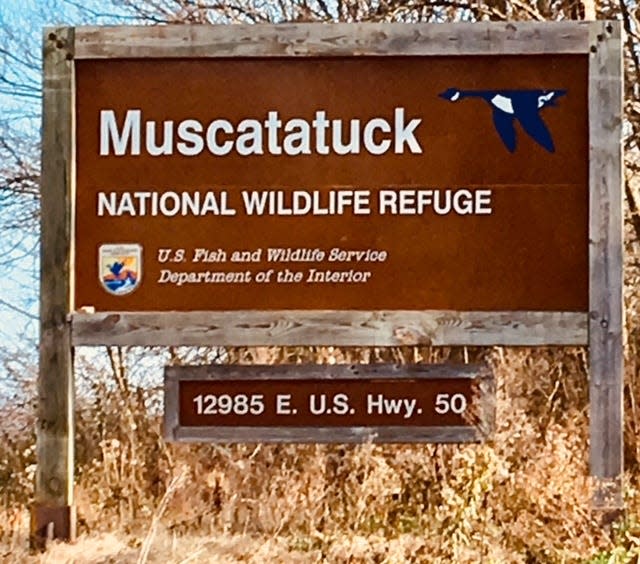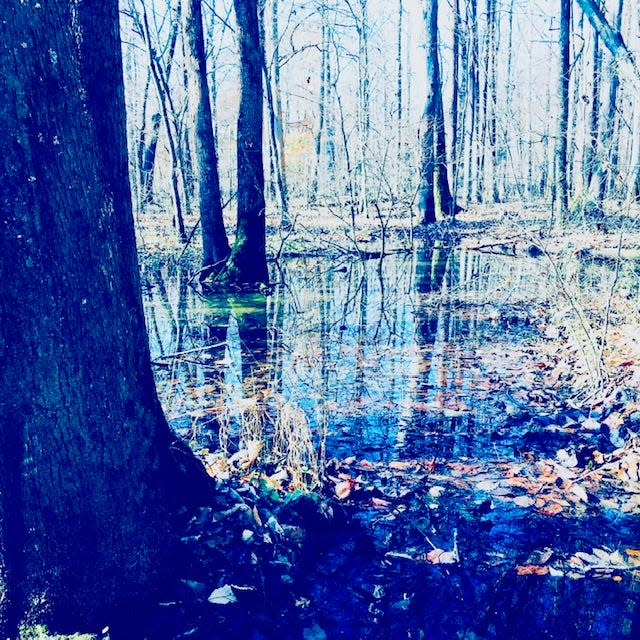A Hiker's Path: An apt sight at Muscatatuck National Wildlife Refuge: Turkeys!
It’s that time of year again: Thanksgiving, a time to be grateful for the good things in my life.
Every year at this time of year, I make the trip over to one of my favorite places to explore nature: the Muscatatuck National Wildlife Refuge near Seymour. This excursion has become a tradition for me, one that I began a few years ago.

The refuge was purchased back in 1966 by the U.S. Fish and Wildlife Service. It was paid for by funds made from the sale of federal "duck stamps." Muscatatuck was Indiana's first national wildlife refuge.
Muscatatuck is a Native American word meaning "land of winding waters."
Water bodies of many kinds are found in this refuge.
The Muscatatuck River, several lakes and ponds, creeks that feed into the river, and natural springs all come together to make up this beautiful wetland refuge.
Located 2 miles east of Seymour on U.S. Highway 50, the refuge includes 7,724 acres of beautiful hardwood trees and wetlands.
Muscatatuck is home to over 280 species of birds with special emphasis given to waterfowl and migratory birds. It is also home to many reptiles and amphibians as well as mammals, fish, butterflies, and more.
It was a few days before Thanksgiving when I made my way over to visit this place.
The November sky overhead was sunny and blue. The temperatures were hovering around the mid-60s. It was a great day to be out on the trail.
I drove over to the wildlife refuge to see what the day had to offer. I pulled into the parking lot of the visitor’s center.
I had decided to start with the Chestnut Ridge Interpretive Trail. It was a small loop trail, only 0.5 miles in length.
I always start with this trail when I visit this place. It’s very scenic and the trailhead is right beside the visitor center.
I started the trail and found myself walking down some steps.
I was immediately surrounded by some fine specimens of hardwood trees. The leaves that had once covered their branches were now covering the ground and the trail. Earth-tone colors made up the landscape, displaying the transition from fall into winter, But not quite yet.
The forest was quiet. I had the place to myself.
I began to follow a boardwalk, one that I am very familiar with. It led me through a small wetlands area.

I caught the scent of fresh cedar trees and damp wood. The smell reminded me of my old childhood home and the old cedar trees that grew there.
I stepped across the boardwalk, enjoying the small pools of water on each side of the boards.
The wetlands part of this trail were my favorite. It was a quick walk through this section and then it was on to the next one.
The next trail I hiked was a bit longer and just as scenic.
The Turkey and Bird Trails, (2 trails that connect), are actually 2 loop trails. Combined they are 1.8 miles in length and are considered easy to hike.
It was probably named after the many birds and waterfowl that make their home in the refuge or use it for a stopover during migration.
The trail winds through a wooded area and a beautiful pine forest. It passes through a wetlands area as well.
I started out on the Turkey Trail totally enjoying the scenery. I inhaled the fragrance of damp pine needles. It reminded me of Christmas and I thought to myself the only thing that would make it better was a little snow on the tree branches and a cardinal sitting on one of them.
A little nostalgia is good on a trail, as long as you don’t get lost in it.
After about a half mile, the Bird Trail intersected with the Turkey Trail.
Not far from where I stood, I surprised a “group” of turkeys. (Not sure who was more startled, them or me).
Officially a group of turkeys is call a rafter. I thought I strange but it’s true. The word “rafter” is derived from the Middle English term gagel, which stems from the Dutch word gagelen, meaning to cackle. The term “gaggle” is used as well. But as far as wild turkeys go, a flock of turkeys is most common.
The Bird Trail looped through a cedar and hardwood forest. The wetlands began on this section and a nice boardwalk was ahead of me. I love walking on the boardwalks through wetlands. It makes me feel like we are getting it right somehow. And it’s so beautiful!
It didn’t take long to finish my trek through this small wetland section.
I finished up and got back into my car to drive around a bit.
There is an auto tour that takes one through different parts of the refuge. It’s 4 miles long. The wildlife you see will depend on what season it is.
Winter is the time to see a good variety of ducks in the refuge including northern shovelers, ring-necks, and blue-wing teal. Tundra swans usually arrive in early December. Approximately 20,000 sandhill cranes winter in the area, feeding in neighboring farmlands during the day and roosting in inaccessible refuge marshes at night.
There is so much more to this place than can be put into this column. A good visit should last 3-4 hours.
All together Muscatatuck has eight hiking trails, ranging from 0.2 miles to 4 miles in length.
My day was finished at last and it had not disappointed. I felt refreshed and relaxed.
To get to this place: From I-65 near Seymour, take U.S. 50 east for two miles to the refuge entrance on the right.
The refuge is open one hour before sunrise to one hour after sunset. It’s open year round and admission is free.
A quote for your week: “We shall never achieve harmony with the land, anymore than we shall achieve absolute justice or liberty for people. In these higher aspirations the important thing is not to achieve but to strive.” — Aldo Leopold, writer, naturalist, scientist, forester, and environmentalist, 1887-1948
Until the next trail, Happy Thanksgiving! Susan
This article originally appeared on The Herald-Times: Hiker sees wild turkeys on pre-Thanksgiving visit to wildlife refuge
